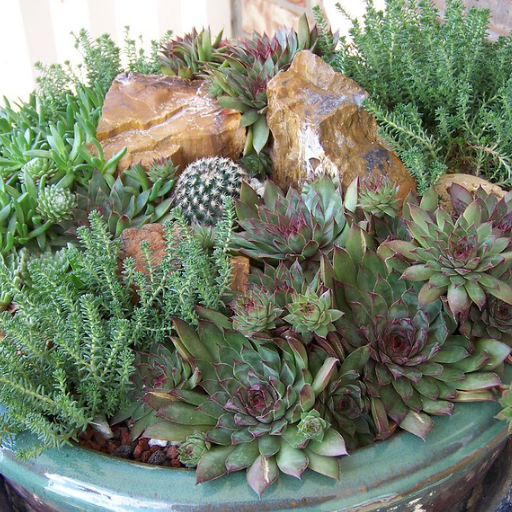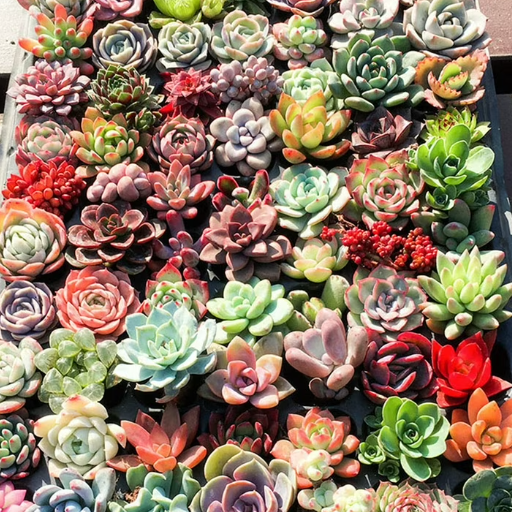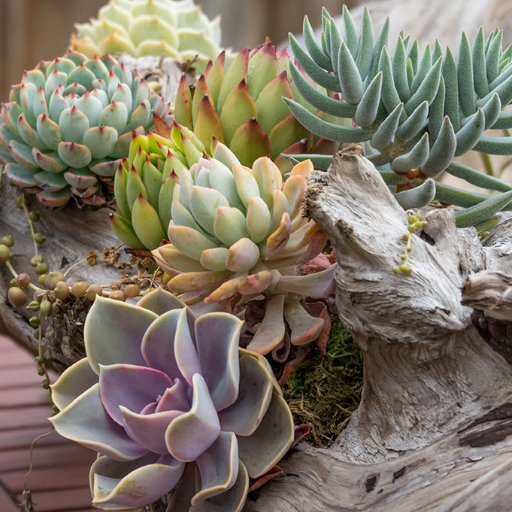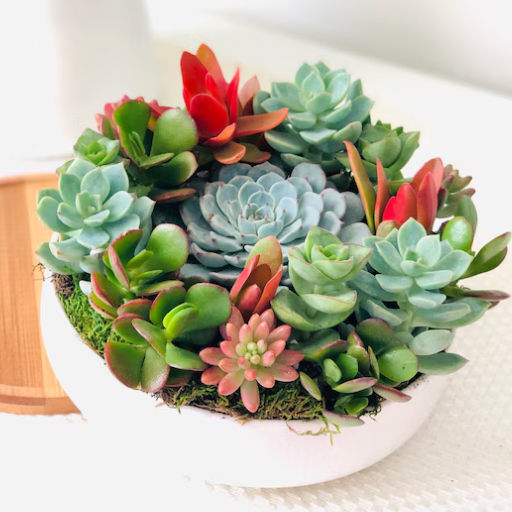The perfect succulent garden is not set up with just attractive succulent plants but also includes companion plants that will make it flourish and improve its aesthetics. This article describes some of the best succulent companion plants to consider for your garden. From colorful flowering plants that pack a punch with color to easygoing green plants that bring out the texture of succulents, we’ll discuss how such combinations can uplift your garden. Directing you to a few essential planting principles, it also looks at how compatible plants make for a balanced and sustainable growing medium. This practical guide is full of useful tips whether you know a bit about gardening or are a complete novice in succulents.
Understanding Succulent Companion Plants

The choosing of succulent companion plants involves the selection of species with similar water and sunlight requirements so that the pot or planter provides a harmonious growing environment. Low-maintenance perennials such as sedum and ornamental grasses, or drought-tolerant flowers like lavender and yarrow, partner well with succulents and bring vibrant colors and interesting textures to the garden. Proper spacing will allow for good air circulation and prevent the plants from being overgrown and neither of which would benefit plant growth or might in fact cause bad growth or disease. Also, the soil, supposed to be well-draining, needs to work together for healthy roots of both sides, avoiding waterlogging. When all these elements are carefully mixed, the results will be a nicely balanced garden that can maintain itself with very little effort.
What is Companion Planting?
Plants grown in company in a synergistic manner so as to bring about better growth, pest deterrent, or just generally better garden health. In my experience, certain plants like to attract beneficial insects or repel harmful ones, while others give the soil some essential nutrients. This increases production but ensures a healthier balance and almost ecological approach to gardening.
Benefits of Companion Planting with Succulents
Through my experience, I found that companion planting with succulents works pretty well with gardens. Succulents, being kind of drought-tolerant, go hand-in-hand with other similar plants for laying down their sustainable and low-maintenance garden design. They conserve moisture in the soil, while at the same time, they serve as an attractive companion that brings a finishing touch to the present gardening space.
Indeed, plants such as aloe and sedum can give repellent fragrances or medicinal properties-thus balancing the function of aesthetics-while remaining the perfect display for any arrangement without appearing to dominate the other plants, which would aid synergy in looks and growth. Desert plants are paired with other plants with similar tolerance to sunlight and soil conditions for great, happy garden beds with little effort.
Factors to Consider for Planting Together
Particularly with mixed planting, I always consider each plant’s individual need to ensure compatibility all the way through and thriving growth. The very first thing to look at was light requirements: put together plants with the same light requirements, such as full sun, partial shade, or full shade. Soil type and soil pH levels should be considered next, judging on the basis of whether or not the plants can coexist in the same soil environment. A plant’s watering requirements may be the most crucial if plants that require widely different amounts of water are forced to cohabit a bed. Space and growth habits are considerations as well, so they may each fulfill their fullest growth potential without infringing on or crowding out their neighbors. This ensures that these factors are aligned in my favor to create a balanced and lively garden that almost takes care of itself.
Best Companion Plants for Succulent Gardens

Whenever planning companion plants for succulent gardens, it pays to choose alternatives that thrive under similar conditions. It is best to choose from drought-tolerant plants such as sedums, portulaca, or some ornamental grasses, all of which share the low-water requirements of succulents. Some herbs, such as lavender and thyme, are a good match, providing visual interest and soft fragrance while resisting dry, well-drained soils. For some color, lantanas or gazanias may be added as flowers that complement succulents and attract pollinators. A plant with similar requirements will, therefore, guarantee a common theme and ease of maintenance for the garden.
Perennial Plants Ideal for Succulents
So, when I select perennials to grow with the succulents, I concentrate my attention on those that favor like conditions. Ornamental grasses such as blue fescue or feather grass really do well with succulents because they tolerate drought and have interesting textures. I am fond of adding myrtle herbs like rosemary, lavender, and thyme that perform well with dry, well-drained soils and please the senses with a lovely scent and good visual appeal. For splashes of lively colors, lantanas and gazanias come to mind-they attract pollinators and work well with the well-established look of a succulent garden. Thus, by pairing plants with the same requirements of water and sun, I develop a landscape that appears harmonious and striking yet one that is low-maintenance.
Annuals That Thrive Alongside Succulents
The annual counterpart to thriving succulents are those that can take similar environmental conditions, that is, abundant sunlight, well-drained soil, and a little watering. Marigolds prove to be an excellent choice as they add a cheerful splash of yellow or orange and are drought tolerant. A companion planting of petunias with succulents can also be tried as these plants bring in bright hues of flowers and also adjust well to dry climates if grown in the right soil. Zinnias are another popular favorite, especially for their bright colors and a great fit for dry conditions. By opting for such hardy annuals, I make sure that the garden remains in a balanced ecosystem while also providing sheer visual appeal throughout the growing season.
Recommended Shrubs for a Dry Garden
When it comes to selecting shrubs for dry gardens, I focus primarily on species that can withstand dry conditions with minimal upkeep. Lavender is among my personal favorites, considering that it can endure dry conditions with proudly scented blooms that attract pollinators. Another favorite is rosemary, which manages well in dry climates and doubles as a culinary herb. When it comes to structure, I go with Russian sage-the silver foliage and purple flowers provide an excellent contrast. With an assortment of these drought-tolerant shrubs, beauty will last a lifetime, requiring far less watering, making them perfect for any gardener concerned about conserving water.
Specific Companion Plants for Succulent Gardens

Appropriate companion plants for succulent gardens are those that grow with similar conditions. Ornamental grasses like blue fescue or purple fountain grass provide a contrasting texture above the succulent and tolerate dry and sunny conditions. Another best choice could be the lavender plant, which imparts hues, fragrance, and pulls in pollinators, with minimum watering. Creeping thyme or sedum work well as ground covers together with succulents, offering a view and keeping the soil moist. Such combinations brighten the outlook of succulent gardens while retaining their low maintenance and water-conserving standard.
Yarrow and Its Benefits
Incredibly versatile, yarrow presents countless opportunities for garden design; it is both useful and decorative. Being able to grow under almost any condition-soil, drought-favoring, low gardener, I value this attribute of yarrow for low-maintenance gardens. With clusters of tiny flowers, they contribute aesthetically while their strong foliage provides texture and structure. Besides being dependent on sight, the yarrow attracts pollinators from bees and butterflies, which contribute to the ecological health of my garden. In addition, I value the medicinal uses that have been traditionally applied to yarrow for the healing of wound inflammation. For any yard-greener looking for a hardy plant that offers many uses, yarrow stands out as one.
Hummingbird Plant: Attracting Pollinators
A hummingbird plant has to be in my garden for pollinating attraction. Bright tubular flowers in colors of red, pink, and orange attract hummingbirds and bees unusually well. From my observation, when planted under full sun and well-drained areas, the plant has a healthy bloom, attracting the pollinators to revisit regularly. A long blooming period paints a splendid array of colors out there and gives back to the ecosystem with nectar for wildlife. Low maintenance and drought-tolerant, the hummingbird plant would fit well into any pollinator-friendly space.
Mountain Pepper: A Hardy Companion
I consider it a favorite hardy plant in my garden due to its resilience and versatility. It loves shady or semi-shaded spots with well-draining soils and demands the very minimum of care. Brilliant reddish stems shine against a backdrop of verdant leaves. Being edible definitely puts this plant in the exquisite category for any landscape project. Its peppery-flavored leaves are used by me as seasoning in cooking to impart a zingy spicy taste to the food. Pruning is necessary to maintain its shape and promote new growth, making it a practical and ornamental choice for gardeners such as myself.
Incorporating Cacti and Other Succulent Plants

Low maintenance and really attractive: these desert plants make an excellent choice for both interior and exterior gardens.-flower view of succulents. These are drought-resistant plants with thick leaves or stems that store water. There are a ton of succulent varieties available to enhance your garden. To best care for these drought-tolerant beauties, plant them in soil that drains quickly, in containers that provide adequate drainage. Keep these plants out of direct sun in bright light and water sparingly, allowing the soil to dry out completely between waterings. A wonderfully diverse plant group by shape, size, and color, succulents can serve as a focal point or just complement the other elements in your garden and require very little maintenance.
Prickly Pear Cactus: A Unique Addition
The prickly pear cactus is an extraordinary choice for anyone looking to add resilience and beauty to their succulent collection. This cactus is celebrated for its paddle-shaped pads and bright blooms; it thrives in well-drained soils and needs infrequent watering, about once every two to three weeks, depending on the weather. While the highest preference is full sunlight, slight tolerance for partial shade permits quite a range of environments to harbor it. Moreover, the prickly pear cactus yields edible pads and fruit, both teeming with nutritive value, hence enriching the aesthetic and utilitarian appeal of your space. You can even enjoy its allure with minimal care, provided you handle the spines gently and ensure that it is planted in a non-humid region.
Flowering Plants That Complement Succulents
On flowering plants that go well with succulents, my suggestions include lavender, yarrow, or evening primrose. These plants do well in low-water environments like succulents, giving vibrant colors and textures complementary to the bold form of the succulents. Lavender will give up its fragrance and soft aesthetic; yarrow will give clusters of bright flowers that attract pollinators. These range from yellow to pink hues of evening primrose that splash some color and align well with dry or drought-tolerant gardens. With these plants, you’ll have a synchronized, low-maintenance, and compelling garden.
Grass Varieties Suitable for Succulent Arrangements
Correct! When choosing grass varieties, I aim to select those that will very well complement the bold shapes of succulents and will also prosper under similar conditions. Ornamental grasses like blue fescue (Festuca glauca) present spiky texture with a compact form and a silvery blue hue, which creates a beautiful contrast with succulents. Another choice is Feather Reed Grass (Calamagrostis acutiflora); it adds vertical interest and pairs well, besides being drought tolerant. Mexican Feather Grass (Nassella tenuissima), to me, presents the softer and more flowing alternative. With its fine soft golden-green blade movement, it melds beautifully with the sculptural form of succulents. These grasses are all hardy and maintenance-free, thriving well in well-drained soil, hence perfect for growing alongside succulents.
Seasonal Considerations for Planting Succulents

Succulent planting should be considered with the seasonal conditions to guarantee optimum growth and longevity. From the best period for planting succulents comes early spring to early summer, while temperatures are quite moderate and daylight increases, strengthening root growth and acclimating the succulents. Never plant any succulent outdoors when it is cold. This would only invite frost damage, something so detrimental to the water-storing leaves. For harsh winter areas, planting in containers for easy moving indoors is a good idea, preferably keeping them where there is some sun and frost-free. We would advise some partial shading during ferocious summer heat to avoid drying and sunburn on your succulents. Planting according to the season means healthy and thriving succulents with minimal stress.
Choosing Plants for Different Seasons
The choices of plants for seasons are always governed by their tolerance of fluctuating temperatures and light requirements. For spring and summer, I inclined toward vibrant, fast-growing kinds of plants like zinnias and marigolds, well-adapted to longer daylight hours. In autumn, the emphasis is on hardy plants, such as mums or ornamental kale that can tolerate cooler temperatures. For winter, hardy evergreen plants and a few indoor plants like snake plant or pothos are preferential choices that grow well with less sunlight. Evaluation of a particular plant for its seasonal adaptability is what gives me the assurance of having a prospering garden throughout the year.
Care Tips for Annuals and Perennials
If there is one thing I do rarely, it is watering annuals with their shallow roots drying fast in warmer months, especially. Also, deadhead the flowers to stimulate new ones throughout the brief life cycle. One applies a balanced, water-soluble fertilizer every two weeks for a vibrant display. For perennials, the focus really comes down to their long-lasting health. When overcrowding takes over, I get dividing to rejuvenate growth, also to improve air circulation. Mulching around the base works to retain moisture and keep soil temperature regulated. Pruning and cutting back the perennials will then be executed at the right time since each has a distinct growth habit that prepares it for its next season of flowering. When one learns to observe, most plants will begin to make all the difference.)
Managing Water Needs in a Mixed Garden
Managing water needs for a mixed garden requires a good eye and a customized approach. I group those with similar water requirements to facilitate watering and avoid over- or under-watering. For drought-tolerant plants, I make sure the soil is well-draining, water deeply, and encourage the development of strong root systems with infrequent watering. In contrast, plants with the higher water requirements are watered regularly, mainly by soaker hoses or drip irrigations to minimize evaporation. I then assess the condition of the soil. If necessary, I add compost or mulch to increase its water-holding capacity. I also adjust the watering times in accordance with weather changes so that every plant receives optimal care.
References
-
Martha Stewart: 11 Companion Plants You Should Always Grow Next to Succulents – This article lists expert-recommended companion plants for succulents, such as Prickly Pear Cactus and Yarrow.
-
Gardenia.net: Great Perennials as Companion Plants for Your Succulents – A guide to perennials that complement succulents, promoting a serene and balanced garden.
-
Gardening Gone Wild: Companion Plants for Succulents – This source discusses various plants, like Lion’s Tail, that pair well with succulents for aesthetic and functional benefits.
Frequently Asked Questions (FAQ)
What are the best companion plants for succulents?
The best companion plants for succulents are those that thrive in similar growing conditions, especially drought tolerant varieties. Low-maintenance plants like agapanthus and red valerian can complement the aesthetic of succulents beautifully. Cacti and succulents often pair well with flowering plants that bloom from late spring to late summer, adding vibrant colors to the arrangement. Additionally, native to South Africa, the kangaroo paw provides stunning orange flowers that contrast nicely with the blue-green foliage of hardy succulents. Consider using statice for its airy texture and excellent drainage properties in your dry garden setup.
How do I care for succulent plants in a container?
Caring for succulent plants in a container requires attention to their specific needs. Ensure that the container has excellent drainage to prevent root rot, which is a common issue for succulents. Use a well-draining soil mix, and consider incorporating sandy or gritty materials to mimic their natural habitats. Many succulents require bright light and grow best in full sun, so place your container in a location that receives ample sunlight. Water sparingly, allowing the soil to dry out completely between watering sessions, as succulents are drought tolerant. Regularly check for pests that may affect their health and growth.
What types of perennial plants can thrive alongside succulents?
Perennial plants that can thrive alongside succulents include those with similar water and sunlight needs. For instance, the evergreen shrub santolina is a great option, as it is not only drought tolerant but also provides a lovely contrast to the textures of succulent plants. Additionally, the striking flowers of african daisies can add vibrant colors to your succulent garden, blooming from late spring to late summer. Incorporating blue fescue grass can also enhance the overall look, providing great texture and a soft contrast to the more rigid forms of succulents. When selecting companion perennials, always consider their growth habits and compatibility with your succulents’ requirements.
What are some annual plants that can complement succulents?
When looking for annual plants to complement succulents, consider those that provide a burst of color and can thrive in similar conditions. Plants such as mimulus, known for their vibrant flowers, can add a lively touch to any succulent arrangement. Another excellent choice is the stunning statice, which offers flowers in shades of purple, pink, and white, creating a beautiful contrast with succulents’ green foliage. Additionally, the orange flowers of kangaroo paw can bring a vibrant pop to the garden. These annuals can be planted in rock gardens or succulent containers, making them versatile options for enhancing your landscape.
How do I create a stunning dry garden with succulents and companion plants?
Creating a stunning dry garden with succulents and companion plants involves careful planning and selection of drought tolerant varieties. Start by choosing a variety of succulents and cacti that suit your aesthetic preferences, ensuring they have similar light and water requirements. Incorporating plants like blue fescue grass will add great texture to your design, while additional flowering companions like red valerian and african daisies can provide vibrant colors. Use rocks and gravel to create excellent drainage and simulate a natural desert environment. Arrange your plants with attention to height and form, ensuring that taller plants do not overshadow the low-growing succulents. Regular maintenance will keep your dry garden looking fresh and vibrant.










